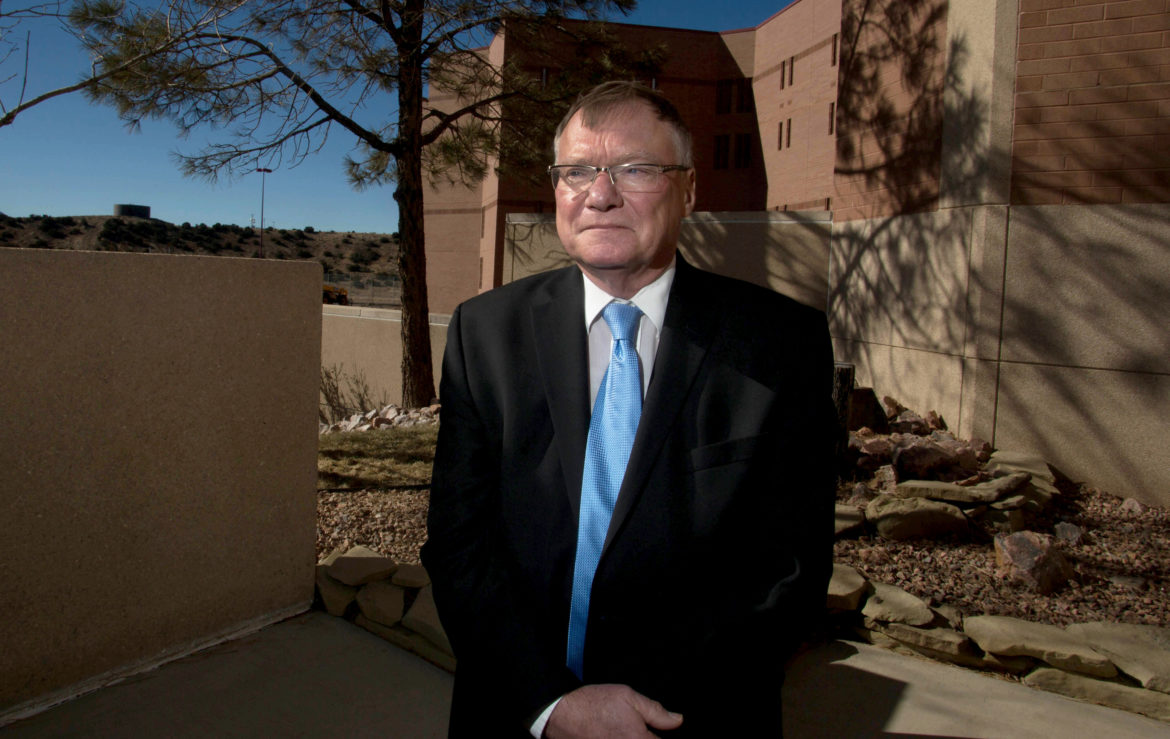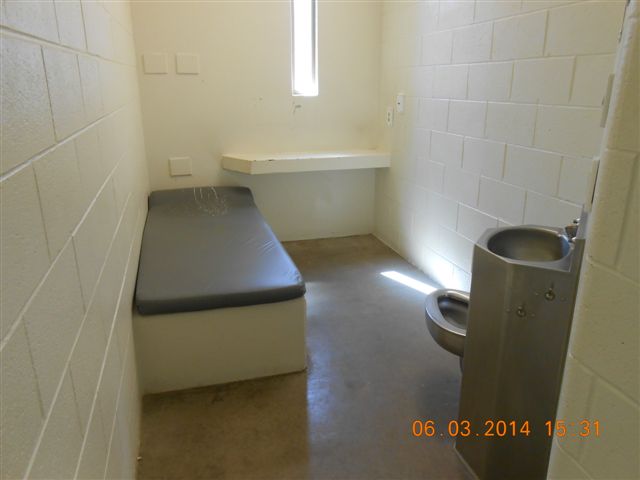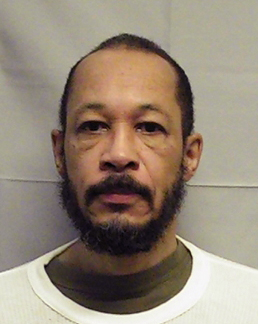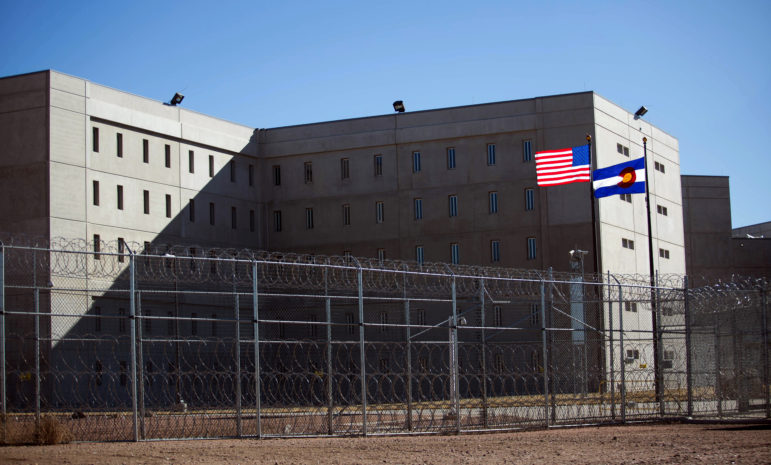How Colorado Reduced Solitary Confinement
It’s nearly been eliminated, while Wisconsin has made only a small reduction in solitary confinement.

Former Wisconsin Corrections Secretary Rick Raemisch stands outside the Colorado State Penitentiary in Cañon City where he famously spent 20 hours in solitary confinement, formerly known as administrative segregation, in 2014. Raemisch now heads the the Colorado Department of Corrections. Says Raemisch: “I’ll tell you right now, segregation doesn’t work — at all.” Photo by Jen Friedberg for the Wisconsin Center for Investigative Journalism.
CAÑON CITY, Colo. — Rick Raemisch sits on the concrete bed in a cell, one of 948 empty rooms in the shuttered Centennial South Correctional Facility. He is recalling the day — actually just 20 hours — that he spent in solitary confinement at the state prison next door.As he looks around the white-walled room, Raemisch declares it fairly similar to the 7-foot by 13-foot cell where in 2014, as head of Colorado’s corrections system, he had himself locked up.
In this cell, he notes the tiny window looking out toward a gravel yard and a concrete wall. There is a stainless steel sink, toilet and a mirror made of metal. The solid purple door has a narrow slot that looks out to a common area.
“The problem with this cell, there’s nothing to count,” Raemisch says, noting the smooth walls. “There’s no chips. There’s no scrapes. There’s no dents. You got nothing to count in here.”

Rick Raemisch, executive director of the Colorado Department of Corrections, sits in a cell similar to the one where he spent nearly a day in 2014. Raemisch found himself pacing, losing track of time and counting nicks in the wall to occupy his mind. And he was there for just 20 hours — not the 20-plus years some Colorado inmates had endured before the state eliminated indefinite use of solitary confinement. Photo by Adrienne Jacobson of the Colorado Department of Corrections.
The reason this cell at Centennial South remains relatively unmarked is that, except for about two years from 2010 to 2012, it has not been used. Colorado’s rapid shift away from solitary confinement — from 1,500 prisoners in 2011 down to 185 as of May — has left the state with a $200 million empty all-solitary prison in Cañon City.
Colorado’s decision to curtail the use of solitary confinement — which the state of Wisconsin has begun to do — offers lessons for the Badger State that Raemisch is uniquely positioned to offer.
Raemisch was secretary of the Wisconsin Department of Corrections from 2007 until Gov. Scott Walker took office in 2011. A Republican, Raemisch was an assistant district attorney and sheriff in Dane County and a federal prosecutor before taking Wisconsin’s top corrections post.
Before the changes, Colorado held some violent or hard-to-manage inmates in isolation for more than 24 years. The state eliminated the use of such long-term, indefinite solitary confinement in 2014; inmates now serve no more than one year in that status, formerly known as administrative segregation and now called restrictive housing-maximum security.
In Colorado, prisoners confined for disciplinary infractions within the institutions now serve a maximum of 30 days at a time, with just a few exceptions. During those stints, inmates are allowed at least four hours a day out of their cells along with other inmates.
Colorado also has banned the use of seclusion for any inmate with a serious mental illness.
Earlier this year, Raemisch took a Wisconsin Center for Investigative Journalism reporter on a tour of three Colorado prisons, allowing access to staff and prisoners.
By contrast, requests by the Center for access to a so-called restrictive housing unit in one of Wisconsin’s prisons, to interview an inmate in solitary or to discuss the state’s solitary confinement policy with an agency official were all rejected. A DOC spokesman cited security concerns and a rule that bans media interviews with prisoners in solitary.

Inmates can spend years, even decades, in a cell like this one at Waupun Correctional Institution under so-called administrative confinement. Colorado and California have eliminated the use of such indefinite solitary confinement. Photo courtesy of the Wisconsin Department of Corrections.
That is not the only difference between the two states. Colorado has several factors that helped it make major changes to its 20,000-inmate system that Wisconsin lacks, including:
- A bipartisan commitment by top political leaders from Democratic Gov. John Hickenlooper on down to reduce solitary confinement;
- A vigorous prisoner advocacy community that meets regularly with Raemisch; and
- Transparency about the treatment of inmates and safety within the prisons, including annual reports to the Legislature and a constituent services office that handles complaints.
In Wisconsin, the number of prisoners in solitary also has dropped, a reduction of nearly 300 to 827 as of late March. Officials say it is due to reduced terms implemented in 2015 for disciplinary infractions.
In addition, 116 inmates are in indefinite administrative confinement for prison safety reasons. Prisoners at Waupun Correctional Institution were started a hunger strike on June 10 in an effort to eliminate such long-term solitary confinement.

LaRon McKinley Bey has sued the Wisconsin Department of Corrections, alleging his 25 years in a form of solitary confinement constitutes cruel and unusual punishment. Photo courtesy of the Wisconsin Department of Correction.
The conditions in administrative confinement in Wisconsin — which are similar to solitary and include 23 hours or more per day in a cell with little human contact or access to natural light — can last for years. In April, Waupun Correctional Institution inmate LaRon McKinley Bey sued the Wisconsin DOC over what he charges is mental torture and physical deprivation during more than 25 years of administrative confinement.
Colorado is not superior to Wisconsin on every measure. Between 2001 and 2013, 19 inmates were killed by other inmates in Colorado state prisons, according to the U.S. Bureau of Justice Statistics. By contrast, Wisconsin prisons had no homicides during that time.
And in Colorado, there are now occasional inmate fights in restrictive housing as prisoners are allowed to congregate in common areas instead of being completely isolated from one another.
“There’s scuffles. There’s fights,” Raemisch said. “When you put people together, that’s going to happen. But the majority have not been serious.”
And agency figures show assaults on corrections staff are down sharply.
Stir crazy in solitary
As he planned his own stint in solitary back in 2014, Raemisch imagined it would be a good time to catch up on sleep.
Instead, Raemisch found himself counting nicks in the wall. He paced. He lost track of time. He craned his neck to catch a glimpse of sky, and he strained to hear a nearby inmate’s TV. The yelling and glare of lights kept him awake for all but a few minutes at a time. At 11 a.m. the next day, he broke his own rule and asked what time it was. Still four hours to go.
The experience, which he also recounted in a New York Times column, left Raemisch shaken — and more determined than ever to finish the job his late predecessor, Tom Clements, had started: to end solitary confinement in Colorado’s prisons.

This $200 million prison in Cañon City, Colorado was opened in 2010 exclusively to house prisoners in solitary confinement. It is now vacant because of the Colorado Department of Corrections’ decision to severely curtail use of isolation. Officials are considering turning the 948-bed facility into a reentry center to help inmates prepare for life after prison. Photo by Jen Friedberg for the Wisconsin Center for Investigative Journalism.
Speaking perhaps as much for himself as for the estimated 100,000 U.S. prisoners a year who endure a form of isolation that many believe is torture, Raemisch said, “If we put you in there for 23 hours a day, you’re going to come out thinking differently than you did when you came in.
“I’ll tell you right now,” he added, “segregation doesn’t work — at all.”
Raemisch’s experiment reinforced his opinion that use of solitary can exacerbate violence and mental illness among prisoners. Colorado’s overuse of solitary confinement was “sending people out worse than when they came in.”
“You can’t put someone with a mental illness in a 7-by-13 cell for 23 hours a day and let the demons chase them around,” he said. “So those who were severely mentally ill in the past, that’s oftentimes where they ended up — sometimes for years.”
In 2014, after hundreds of prisoners were returned to less-restrictive settings, inmate-on-inmate violence rose, according to the most recent eight years of data provided by the Colorado DOC. From fiscal year 2008 through fiscal year 2015, the average annual number of inmate-on-inmate assaults was 432; in 2015 it was 520. And there were 723 fights in 2015 — the highest in eight years.
But assaults on staff decreased significantly. Between 2008 and 2013, there were an average of 262 assaults on staff per year. But those numbers dropped to 188 in 2014 and 160 in 2015.
Article Continues - Pages: 1 2
Cruel and Unusual
-
Jail Fees Can Leave Inmates in Debt
 Oct 4th, 2019 by Izabela Zaluska
Oct 4th, 2019 by Izabela Zaluska
-
Rules Violations Cause 40% of Prison Admissions
 Jul 3rd, 2019 by Izabela Zaluska
Jul 3rd, 2019 by Izabela Zaluska
-
Evers Faces Hurdles to Cutting Prisons
 Jul 1st, 2019 by Izabela Zaluska
Jul 1st, 2019 by Izabela Zaluska




















“Solitary confinement”: Many people in power conspire to oppress our rights and spirits as individuals in order to enforce their dim and dark version of social order.